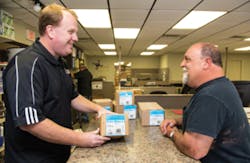In January 2014, President Obama’s “Reduction of Lead in Drinking Water Act” (or Senate Bill S.3874) will be in full force, setting a new federal standard for the level of permissible lead in plumbing fixtures that carry water for human consumption. The Act states that the allowable lead content in products providing water for human consumption changed from a previously-allowable level of up to eight percent to an average content of less than 0.25 percent.
The new bill aligns allowable lead levels in all 50 states. These laws do not prohibit the use of components containing more than 0.25 percent lead, but rather define a calculation to determine the lead content of the average wetted surface in the product. It is this average wetted surface that must contain less than 0.25 percent lead.
The new law is just as important for water quality dealers as it is for plumbers, perhaps even more so. After all, plumbers may install an entire potable water system, but they are often not the professional responsible for the water quality or treatment of the water, within a home or business. That’s usually the purview of the water treatment company, making this new legislation very important to water quality pros.
At first glance, the legislation appears sufficiently simple and straightforward. Unless, that is, you are in the business of installing, specifying, distributing or manufacturing new compliant products and technologies. There’s more to it than meets the eye.
In the beginning
The crucible moment happened with California’s precedent-setting introduction of Assembly Bill 1953 (AB 1953). In 2007, the bill was passed into law and became California Health and Safety Code Section 116875. Vermont had its own lead free legislation in process and quickly adopted the California language. Maryland also passed lead free legislation mirroring California’s. California enacted additional controls, not yet adopted by other jurisdictions; specific to manufacturers is the need to certify products as compliant to the law with an ANSI-accredited third party.
The new federal law builds from these state level efforts to control lead in plumbing that conveys water for human consumption. At the manufacturing level, it’s now a ramp-up process to phase-in the lead free products while phasing-out the existing ones.
As manufacturers across the nation transition to lead free plumbing materials, a wide range of issues interact between product development, manufacturing process, distribution and even metal recycling. Here’s a quick look at some of what’s involved.
The first step in complying with the new legislation is to understand the scope of the law. The California law was built around removing lead from water consumed through drinking or cooking. Yet, there are many uses of plumbing products and technology outside the scope of the California law such as irrigation, fire protection, heating systems and industrial uses.
Manufacturers must review their product offering and generally separate it into one of four groups:
- Compliant as is, regardless of intended use
- Product only used in lead free required applications and must be reconstituted
- Product to be used in either lead free or existing applications
- Products not to be used to convey water for human consumption.
Materials and manufacturing
Selecting lead free materials is not as simple a process as it would seem. There are many options available to manufacturers, and each option has its own set of limitations. When complying with the lead free laws, there are many variables to address that cover multiple manufacturing processes, while being mindful of material suitability and product cost.
The primary options available for materials are lead free brass and bronze, stainless steels and plastics. Each lead free technology has costs beyond the basic raw material to consider.
“Manufacturers have a responsibility to deliver lead free compliant products that meet the customers’ expectations for performance and serviceability. With the various material options that are available to meet the requirements of the lead free statutes, development of a material strategy is critical to maintain performance and deliver value to the end user,” says Jeff Scilingo, director of R&D engineering for Watts Water Technologies.
Casting lead free alloys is not as simple as it was with leaded formulations. New techniques and tooling have been developed and refined to process the new materials. When forging the lead free alloys, tighter temperature controls are required to maintain material performance.
Ongoing development continues to produce new material options.
“An organization must continuously monitor the materials market and apply a sound material strategy. [Manufacturers should] seek to align engineering performance ‘must haves’ with available manufacturing processes to ensure that new lead free products maintain expected levels of performance and serviceability when compared to traditional materials,” explains Joe Burke, principal engineer at Watts Water.
Answering customer questions
In addition to the manufacturing and logistical challenges, all manufacturers have addressed lead free needs with their customers. Water quality dealers, understandably, have asked questions like these:
- What products are affected by the law?
- How do you identify lead free compliant products versus non-compliant products?
- How does the change affect costs?
- How do changes in the law impact our business or end users?
Answers can be given through training and education on the ground, advertising campaigns, educational literature and informative web resources such as www.WeAreLeadFree.net.
Most of the information to questions like these, and many more, can be found on this website. Of course, if dealers would prefer to ask questions by phone or in person, they should call their local branch professionals.
Partnering with a manufacturer that understands the impact of the law and has experience with the challenges of a change of this size is important. Ultimately the goal is to offer products that provide safer, cleaner water for families, communities and the future.
Cora Dietz, CWS-VI, is the branch sales manager for Watts Water Quality’s new Twinsburg, Ohio branch. Dietz is also the president of the Ohio WQA. She can be reached at [email protected].


